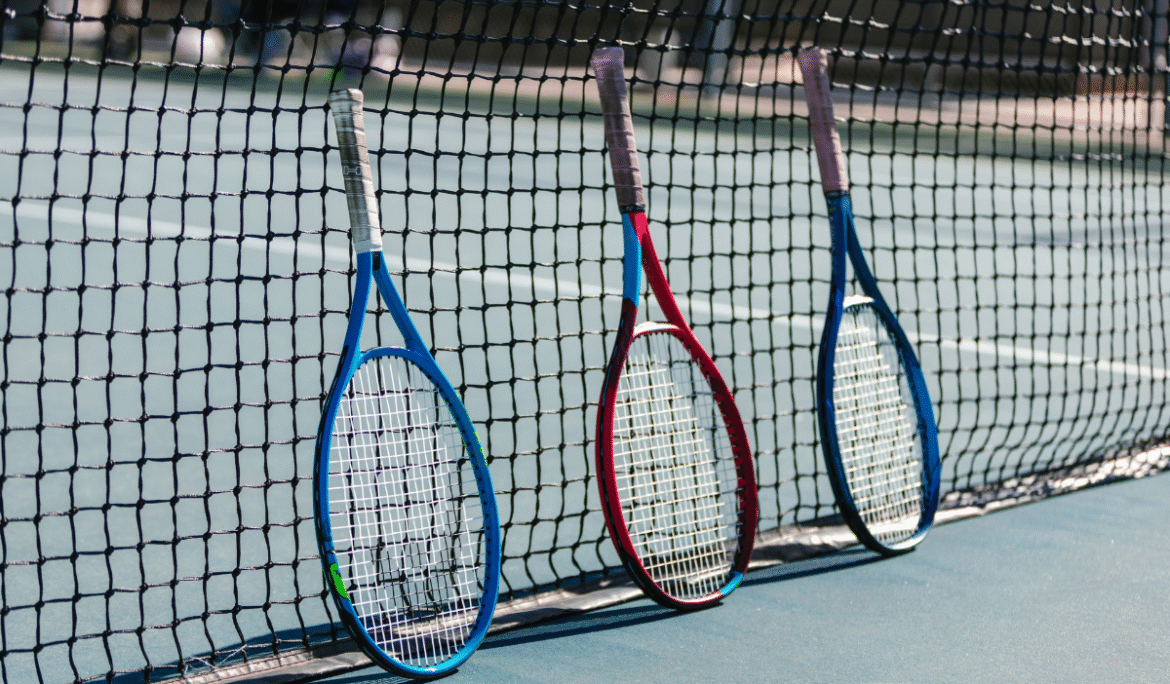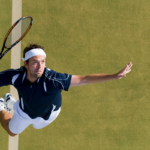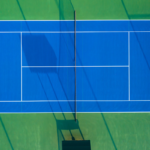Why the Right Racket Matters
Selecting your first tennis racket can be overwhelming. Walk into any sporting goods store, and you will see a wall of rackets, in colors and sizes and weights. As a new player, it’s difficult to figure out which one will allow you to learn the game, and which one will set you back.
The fact of the matter is, the racket does actually matter. An ideal fit can provide you with a sense of confidence, prevent your frustration and even avert common injuries such as tennis elbow. This guide unpacks the key considerations you must be aware of to make a smart decision and get your tennis career moving with a foot on the right direction.
Every day at Infinity Racquet Club in Fulshear TX, our professional coaches work with beginners on choosing a racket, technique, and training. No matter if you’re an adult getting started later in life, or a junior hitting their first shot, in this guide (as well as our free trial lesson) will have you off on the right foot.
Key Factors for Beginners to Consider
Every racket is a combination of specifications, but beginners should focus on a few that really matter.
- Racket Head Size: The head size is responsible to determine how large your sweet spot is—the point in the strings that gives you an accurate, forceful shot.
- Oversized (105–115 sq. in.): Best for most beginners. Bigger sweet spot, very forgiving on off-center shots, easy power.
- Mid-plus (98–104 sq. in.): Power, control and just a tinge less forgiveness. Better for intermediates.
- Mid-size (<98 sq. in.): For advanced players that consistently hit in the sweet spot.
👉 Beginner Tip: Start with an oversized racket. It’s designed to help you build confidence and get the ball over the net more often.
2. Weight
The weight of a racket impacts maneuverability and stability.
- Lightweight (9–10.5 oz / 255–295 g): Ideal for adult beginners. Easy-waving reduces tiredness and protects the wrist and elbow.
- Medium (10.6–11.5 oz / 300–325 g): More control oriented, best for players with compact strokes.
- Heavy (11.6+ oz): The kind of dart you’d see in a pro dart match. Too demanding for beginners.
👉 Rule: Always choose a racket that feels comfortable for multiple rallies without strain.
3. Balance
Balance refers to how the racket’s weight is distributed.
- Head-Heavy: Generates more power with less effort. Common in beginner-friendly rackets.
- Head-Light: Offers more control, great for volleys and net play. Suited for advanced players.
- Even Balance: Best choice for beginners, offering a mix of both.
4. Grip Size
A proper grip size is crucial to avoid wrist and elbow problems.
How to find your grip size:
Hold the racket like you’re shaking hands. Place your other hand’s index finger between your palm and fingers. If there’s no space, the grip is too small. If there’s too much space, it’s too large.
👉 Always choose a slightly smaller grip—you can add an overgrip if needed.
5. Material & Budget
You don’t need to spend a fortune.
- Aluminum: Affordable and durable but stiff.
- Composite (Aluminum + Graphite): Balanced, lightweight, good value.
- Graphite: Best performance, comfortable, and lightweight.
💡 Price Range: Most quality beginner rackets cost $80–150. Focus on comfort, not price tags.
The Beginner’s Racket Buying Checklist
When buying your first racket, follow these steps:
- Head Size: 105 sq. in. or larger.
- Weight: Under 10.5 oz.
- Grip Size: Use the index finger test.
- Balance: Even or slightly head-heavy.
- Budget: $80–120 is ideal.
- Demo Before Buying: Always test if possible.
👉 At Infinity Racquet Club, you can demo rackets during trial lessons before investing.
Common Beginner Mistakes to Avoid
- Buying a pro-level racket too soon: Heavy, small-headed rackets can hurt progress.
- Choosing based on brand or looks: Performance matters more than paint jobs.
- Ignoring grip size: This is critical for comfort and injury prevention.
- Not testing rackets: Swinging before buying is the best way to know what feels right.
Comparison: Beginner vs Advanced Rackets
|
Feature |
Beginner Racket |
Advanced Racket |
|
Head Size |
105–115 sq. in. |
95–98 sq. in. |
|
Weight |
9–10.5 oz |
11–12 oz |
|
Balance |
Even or Head-Heavy |
Head-Light |
|
String Pattern |
Open (16×19) |
Dense (18×20) |
|
Price |
$80–150 |
$200+ |
How Racket Choice Affects Training
Your racket directly impacts how quickly you learn.
- Groundstrokes: Oversized rackets make hitting consistent forehands/backhands easier.
- Serving: Lightweight rackets reduce fatigue during repetitive serve practice.
- Volleys: Even-balanced rackets help improve reactions at the net.
- Rally Drills: Correct grip size ensures control during long rallies.
👉 At IRC, we align training drills with racket selection so you progress faster.
Best Beginner Rackets in 2025
|
Brand & Model |
Head Size |
Weight |
Balance |
Price |
Best For |
|
Wilson Clash 108 |
108 sq. in. |
10 oz |
Even |
$120–150 |
Adults starting fresh |
|
Babolat Boost Drive |
105 sq. in. |
9.8 oz |
Head-Heavy |
$110–140 |
Power learners |
|
Head Ti.S6 |
115 sq. in. |
8.9 oz |
Head-Heavy |
$90–110 |
Seniors & casuals |
|
Yonex Ezone 110 |
110 sq. in. |
10.5 oz |
Even |
$130–160 |
Balanced beginners |
|
Prince Warrior 107 |
107 sq. in. |
10.2 oz |
Even |
$100–140 |
All-rounders |
FAQs on Beginner Rackets
Q1. Do I need an expensive racket to start?
No. $80–120 rackets are perfect for learning.
Q2. Should I get a pre-strung racket?
Yes. Most beginner rackets come pre-strung—convenient and cost-effective.
Q3. How often should I restrain?
As many times per year as you play per week. Beginners usually restring once or twice annually.
Q4. Can kids use adult rackets?
No. Junior rackets are scaled to a child’s height and grip.
Q5. What’s better: power or control rackets?
Start with power-friendly oversized rackets, then move to control later.
Q6. Which material is best?
Graphite composite offers the best mix of comfort and performance.
Q7. How do I know if the grip size is correct?
Use the index finger test, or ask an IRC coach.
Q8. Can I rent/demo rackets at Infinity Racquet Club?
Yes. Demo rackets are provided during lessons and camps.
Q9. Will the wrong racket cause injury?
Yes—too heavy or wrong grip size can cause tennis elbow or wrist pain.
Q10. When should I upgrade?
When you consistently hit the sweet spot and want more control.
Q11. What brands are beginner-friendly?
Wilson, Head, Babolat, Yonex, and Prince all offer great entry-level rackets.
Q12. Should seniors choose different rackets?
Yes—lightweight oversized frames with low tension are ideal for joint comfort.
Why Infinity Racquet Club is the Best Place to Start
At Infinity Racquet Club in Fulshear, TX, we simplify racket selection and training:
- Free 30-minute trial lesson with demo rackets.
- On-site stringing tailored to your style.
- Certified coaches for personalized recommendations.
- Beginner-friendly community with events, camps, and mixers.
📍 Address: 6215 Teal Rd, Fulshear, TX
📞 Call: 346-318-3556
🌐 Book your free trial today
Conclusion: Start Strong, Play Better
Your first tennis racket sets the tone for your game. Focus on head size, grip, weight, and comfort—not brand names or pro endorsements. With the right choice, you’ll rally longer, serve smoother, and enjoy the game more.
At Infinity Racquet Club, we combine professional coaching with equipment guidance so you never have to choose alone. Start smart, and your tennis journey will be more rewarding from day one.
👉 Book your free trial now and let our experts help you pick the perfect beginner racket.







